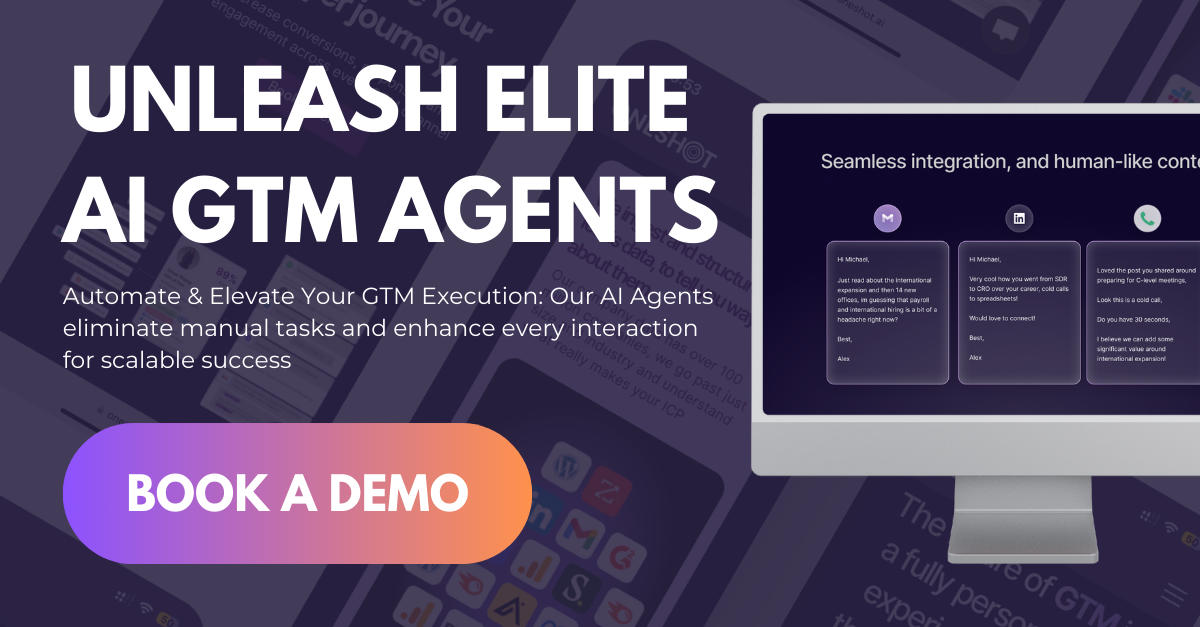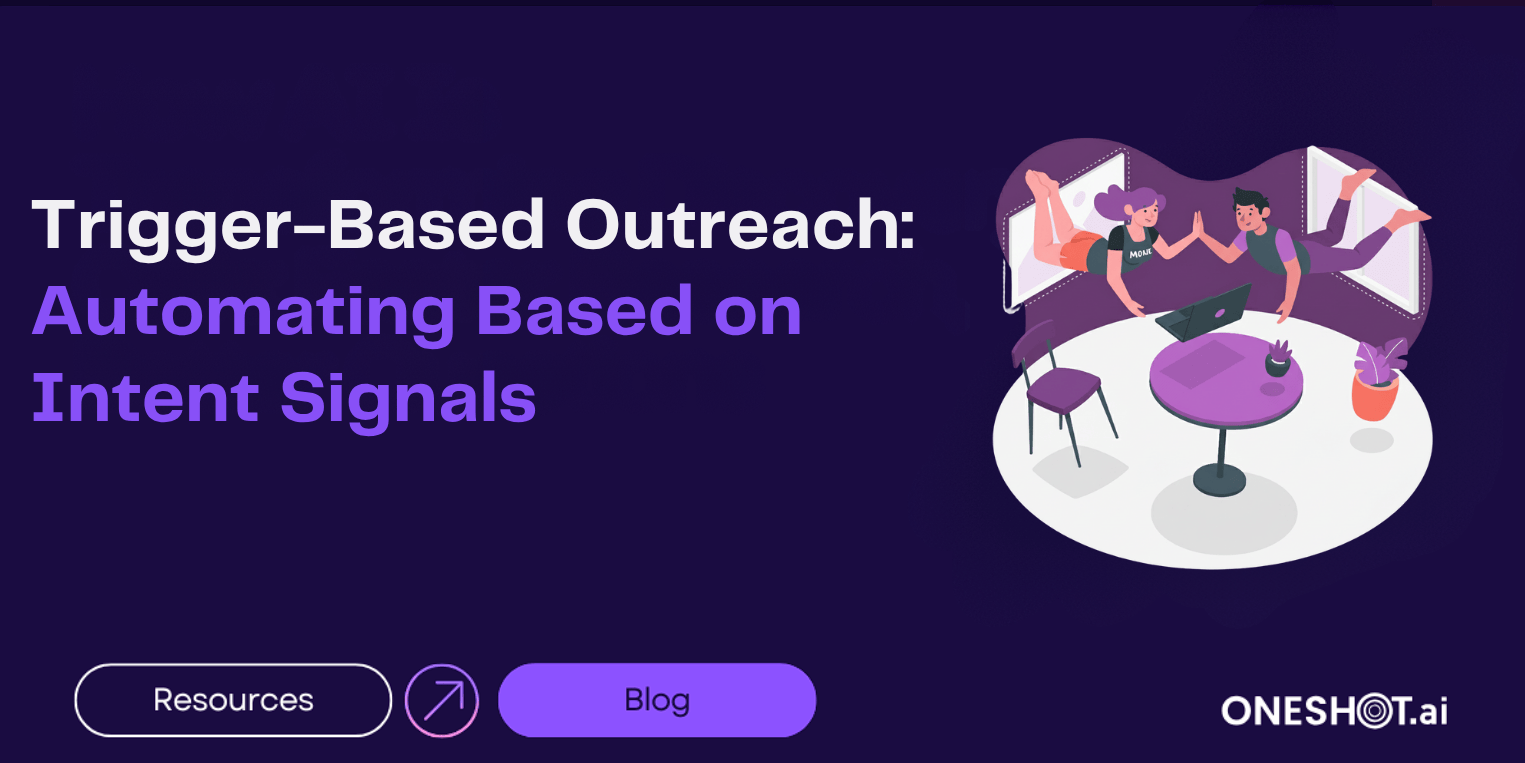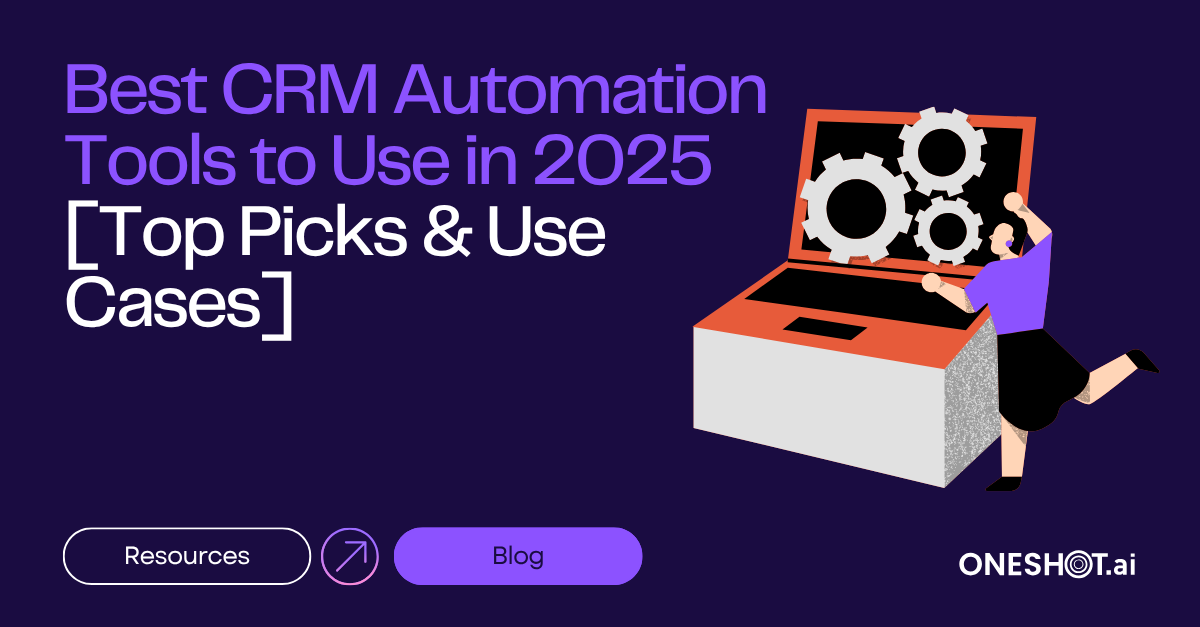Trigger-based outreach is an effective technique for connecting with prospective buyers at the most opportune moment, according to their buying signals. In an era where conventional selling practices tend to hinge on cold calling and blanket outreach, trigger-based outreach taps into specific activities or events signifying buying intent.
With data-driven outreach, sales representatives can spot the ideal moment to connect, greatly improving the chances of a successful dialogue. With the growth in AI, it’s simpler than ever to automate this with intent signals – automating a timely and personalized sales strategy at scale.
What Is Trigger-Based Outreach and Why Is It Critical in Modern Sales?
Trigger-based outreach is a sales technique that utilizes particular signals, or “triggers,” to open dialogue with prospects when they are most receptive. Unlike conventional sales practices that depend more on initiating contact with cold prospects, trigger-based outreach engages people or entities with purchasing intent, thus making it timelier and more relevant.
With today’s fast-moving marketplace, where competition for customers is cutthroat, attracting customers to find you is no longer sufficient. Intent signal-based automated outreach guarantees sales teams are reaching out to prospects at the exact moment of intent, significantly accelerating conversion rates and shortening the sales cycles.
How does trigger-based outreach differ from traditional sales outreach?
Conventional sales outreach relies on cold calling, email blasting, and hoping for prospects to initiate interest. Trigger-based outreach, however, uses data to target prospects who are demonstrating buying intent through certain activities or events.
By monitoring signals like website visits, content engagement, job change, or company funding rounds, trigger-based outreach positions sales teams to target leads who are actively weighing a purchase, driving more productive and efficient sales.
What are “intent signals” in outbound prospecting?
Intent signals are behaviors or events that signal a prospective buyer's interest or willingness to buy. Such signals can be online activity, such as product page visits, reading a blog article, or downloading a whitepaper.
More sophisticated signals are job changes, rounds of funding, or company tech stack changes. By picking up on these cues, sales teams can adapt their follow-ups to meet the prospect's urgent demands, making the communication significantly more pertinent and timely.
Why is intent data a game-changer for high-converting outreach? What kinds of buyer triggers signal high intent?
Different buyer triggers signal high intent, such as a change in a prospect's job, funding rounds, or tech stack. For instance, a career shift in a target company may indicate that the lead might have added responsibility and a possible need for alternative solutions.
On the same note, a funding event might indicate that the firm is poised to invest in new tools or solutions. Other intent triggers, such as reviews on sites such as G2 or software downloads, can offer straight insights into the prospect's immediate pain and willingness to have a purchase conversation.
How can B2B teams use real-time data to increase reply rates and reduce time-to-close?
B2B teams can leverage real-time intent data to react promptly to prospects demonstrating readiness. By automating the detection of buyer signals, sales teams can receive alerts when a lead shows interest, allowing them to engage in real-time.
This reduces the time-to-close significantly by ensuring that sales teams are always engaging prospects at the most opportune moment. Moreover, using real-time data makes outreach more relevant, which increases the likelihood of a response, enhancing the overall sales process.
See How OneShot.ai Identifies Buying Signals in Real-Time → Test a Demo
Where Do Intent Signals Come From and How Are They Captured?
Intent signals are derived from various sources and types of interactions, and can be included as a first-party signal or third- party signal. First-party intent signals are derived from prospects' interactions with your website, content, or emails and can be considered personal in that they reflect the specific individual or organization's interests and behaviors.
Third-party intent signals are from other sources (e.g., social media platforms, industry news, outside interest data providers). Reviewing both sets of signals provides sales teams with a better contextual view of a prospect's showing intent to purchase.
What are first-party vs. third-party intent signals?
First-party intent signals are behaviors that your prospects perform directly on your site or due to your content. Examples of such signals are browsing certain product pages, requesting a demo, or submitting a contact form.
Third-party intent signals, on the other hand, originate from third-party data sources such as news publications, social media posts, or intent data platforms. Both are important to know a prospect's intent and adjust outreach strategies based on that.
What tools or platforms provide reliable intent data feeds?
Reliable intent data can be obtained from platforms such as Bombora, 6sense, G2, and LinkedIn. Bombora and 6sense offer aggregated intent data from online activities on a variety of websites, enabling sales teams to identify companies interested in certain topics.
Platforms such as G2 and LinkedIn are also rich with insights on user reviews, job transitions, and content engagement around related topics, making intent signals even more accurate. These platforms seamlessly fit into sales processes so that teams have the freshest and most applicable data at all times.
How does website behavior—like pricing page visits or form abandonment—indicate buying intent?
When a lead is visiting a pricing page or leaving a form, it is an indicator that they are very interested in purchasing, but perhaps something is stopping them from going through with the action.
Such behaviors are obvious signals that the lead is contemplating a purchase but could perhaps use some more information or a push to continue. Sales teams can follow up in a timely manner, giving further details or responding to issues, which can result in an improved conversion rate.
Are CRM and email engagement data suitable trigger signals?
Absolutely. CRM and email engagement data are super effective at measuring buying intent. Email engagement triggers, such as when a prospect engages with your content by opening an email, clicking on a link, or replying to a message, are effective indicators of engagement with your content in real-time. Couple this with CRM data, which gives insight into where in the funnel a prospect may exist - and you can easily determine how and when to engage.
When you overlay these intent signals with other intent signals in an effective manner, sales teams can deliver meaningfully personalized outreach at the right time.
How does OneShot.ai integrate diverse signal sources into its outreach engine?
OneShot.ai pulls in several of these intent signal sources, including website behavior, CRM engagement, social signal engagement, and 3rd party intent data, into its outreach engine. By pulling in these various data sources, OneShot.ai gives sales teams a complete picture, which helps with intent.
This full view of intent helps with timely and personal outreach to prospects, so there's a greater possibility to engage with greater relevance, leading to increased conversion.
See How OneShot.ai Automatically Sources Leads → Book a Demo

How Can Automation Tools Use Intent Data to Personalize Outreach?
Automation software can take intent data and tailor outreach in ways that would be unfeasible for a human to accomplish by hand at scale. By mixing intent data in real-time with automation, tools such as OneShot.ai can create incredibly personalized messages that are aligned with the prospect's immediate needs and activity.
The outcome is outreach that is more relevant and timely, making it dramatically higher in engagement and conversion rates.
What are real-world examples of trigger-based automated messages?
An example of real-life automated messaging with a trigger could be an email to a prospect who has just downloaded a whitepaper or viewed a product page on your site.
The email would mention their particular interest and provide further information or a demonstration of the product. Another is an outreach email after a prospect's company makes a funding announcement, providing solutions that meet the company's new resources and growth aspirations.
How does OneShot.ai’s Insight Agent enhance lead context using intent signals?
OneShot.ai’s Insight Agent enhances lead context by collecting and analyzing intent signals across various channels. It then uses this data to automatically enrich each lead’s profile, ensuring that sales teams have the most up-to-date information on the prospect's behaviors, needs, and readiness to purchase. This enriched context enables sales teams to craft highly relevant, personalized outreach that resonates with prospects, improving conversion rates.
How do NLP and LLMs boost personalization based on behavior?
Natural Language Processing (NLP) and Large Language Models (LLMs) assist in automating and customizing outreach through the analysis of prospect behavior and the creation of messages that resonate with the prospect's interests and preferences.
NLP may be able to analyze previous interactions, while LLMs can produce dynamic email copy or sales scripts specifically designed for each person. This synergy enables hyper-personalized messaging that is natural, growing the likelihood of engagement and conversion.
How does dynamic content work in cold emails, LinkedIn outreach, and call scripts?
Dynamic content enables sales teams to customize their outreach in real-time according to a prospect's behavior and intent signals. For cold emails, dynamic content might include personalized mentions of the prospect's firm or industry, while for LinkedIn outreach, it might include referencing recent news or job changes. Call scripts can also be customized based on real- time data so that the conversation is timely and relevant.
What are the risks of over-automation vs. personalized automation?
While automation can enhance efficiency, over-automation can result in robotic, impersonal outreach that doesn't resonate with prospects on a personal level. It's critical to balance automation and personalization so that outreach is timely and relevant without sacrificing the personalization that fosters relationships.
Look at how Our Personalization Agent composes messages that convert → Discover features
What Are the Most Effective Trigger Events to Build Outreach Campaigns Around?
Successful trigger events for outreach campaigns are changes in jobs, funding rounds, competitive tech installations, and company growth.
All of these events represent a potential requirement for your product or service and thus offer a prime opportunity to initiate the prospect. By correlating trigger events to the right stage of the sales funnel, sales teams can frame their messaging to address the prospect's particular needs and pain points.
Which job changes signal B2B purchase intent, and how can you respond?
Job changes, particularly at decision-maker or leadership levels, tend to indicate that a prospect's requirements are undergoing a change. Reaching out promptly after a job change can be an opportunity to present solutions catering to the responsibilities of the new role. For instance, a fresh CTO could be planning to advance the company's technology stack, and this presents the ideal time to reach out.
Does company funding or expansion suggest a receptive lead?
Funding rounds or business expansions typically indicate that a company is growth-focused and potentially poised to invest in new solutions. Quick action is paramount in these cases to take advantage of the company's expanded budget and willingness to adopt new tools. Messaging must target assisting the company in scaling and attaining its growth goals.
How can competitive tech install or uninstall events become opportunities?
When a prospect installs a competitor's technology or when they remove a product, there is a great opportunity to showcase how your solution will best suit their needs. If sales teams can keep an eye on tech stack changes, it allows them to reach out to prospects during a time of real potential pain and show them a compelling alternative.
How can sales teams detect and map trigger types to funnel stages?
Sales teams can identify trigger events and map them to the right stage in the sales funnel by monitoring the trigger signals, content engagement, product interest, or changes to the company status itself.
For example, if a prospect goes to their pricing page, this might signal that they are towards the decision-making stage. If a company announces significant funding, that could represent a top-of-funnel opportunity.

How Does OneShot.ai Automate Trigger-Based Outreach at Scale?
OneShot.ai automates triggered outreach at scale by bringing intent data from a variety of sources and hyper-personalizing messaging for each lead. Its Insight Agent identifies and processes intent signals, adding context to lead profiles to make sure outreach is timely and relevant.
The Personalization Agent then creates bespoke messages, while the Scaling Agent makes sure that the volume of outreach is synchronized with hyper-specificity.
How does OneShot.ai's Insight Agent detect and analyze intent data?
OneShot.ai’s Insight Agent uses a combination of first-party and third-party intent data to analyze lead behavior, identifying buying signals across multiple touchpoints. This allows the system to provide timely alerts when a prospect is exhibiting high intent, enabling sales teams to act quickly and engage with the right leads.
How does the Personalization Agent convert buyer signals into relevant messaging?
The Personalization Agent uses the intent signals identified by the Insight Agent to create personalized contact messages that address the particular needs of each prospect. Whether via email, LinkedIn message, or phone call, the messages are developed to speak to the prospect's existing pain points and buying signals.
How does the Scaling Agent balance volume with hyper-specificity?
The Scaling Agent allows OneShot.ai to automate outreach at scale, without sacrificing humanity. With the Scaling Agent, volume can coexist with hyper-specificity to make every message relevant and timely at the scale of hundreds and thousands of prospects.
What CRMs and tools can a sales team use with OneShot.ai as an intention data source for outreach?
OneShot.ai integrates with popular CRMs and tools like HubSpot, Salesforce, LinkedIn, and others, so sales teams can work with intent data while remaining within their preferred platform.
OneShot.ai integrations provide a seamless experience so all outreach steps and lead management can be organized more easily, while also having automated forms of outreach.
Scale Intent-Based Outreach Without Losing the Human Touch — Get Started with OneShot.ai
What Are the Measurable Benefits of Intent-Based Automation in Sales?
Trigger-based outreach is quantifiably positive, with more reply rates, better deal velocity, and increased conversion rates. Through automated outreach driven by real-time intent indications, sales teams can quickly and effectively respond to prospects, generating more efficient conversations and accelerated sales cycles.
How much does trigger-based outreach improve reply rates and deal velocity?
Trigger-based outreach has been demonstrated to have a dramatic effect on response rates and velocity of deals. By reaching prospects at the time when they are most engaged, sales teams are able to achieve a dramatic boost in response rates and hasten the sales cycle. Reply rates can be doubled or tripled in some instances compared to standard outreach.
What do benchmark stats say about intent-driven outreach ROI?
Benchmark figures from tools such as Bombora and 6sense indicate that intent-based outreach dramatically beats default sales approaches. For instance, it has been reported that firms using intent data have experienced as much as a 30% boost in conversion rates and a 20% shorter sales cycle.
How do sales teams credit pipeline growth to signal-based messaging?
Sales teams can attribute pipeline increases to signal-based messaging by monitoring the origin of every lead and studying the effect of particular intent signals on conversion rates.
Sales teams can improve and optimize their outreach strategies for optimal ROI by quantifying the effectiveness of various signals and campaigns.
Final Words
Companies can leverage an intent signal-based approach with a blend of automation and personalization (for example, with OneShot.ai, to name a few) to scale this effort and keep the human, personal piece of engagement. The outcome is higher rates of reply, faster deal velocity, and shorter sales cycles. For today’s B2B teams who rely on prospecting, a trigger-based outreach strategy is not a competitive differentiator; it is quickly becoming the way for B2B teams to raise their prospecting to a more strategic and effective level.
Want to make intent signals work for you in a smarter outreach strategy? → Get Started with OneShot.ai Now
FAQs
1. What is trigger-based outreach in marketing?
Trigger-based outreach refers to automating sales or marketing actions based on specific customer behaviors or intent signals. For example, an email or call may be automatically triggered when a lead visits a pricing page or engages with content.
2. What are the three main types of triggers in automated processes?
Automated processes typically use three types of triggers: behavioral (user actions), time-based (specific dates or intervals), and event-based (system or workflow events). These triggers help deliver the right message at the right time.
3. How does trigger-based outreach use intent signals?
Intent signals—like website visits, content downloads, or email engagement—inform AI or automation platforms about a lead’s readiness to buy. Trigger-based outreach leverages these signals to personalize communications and optimize conversion rates.
4. What is the benefit of automating outreach based on triggers?
Automating outreach ensures timely, personalized communication without manual intervention. It increases engagement, improves lead conversion, and allows sales teams to focus on high-value interactions.








